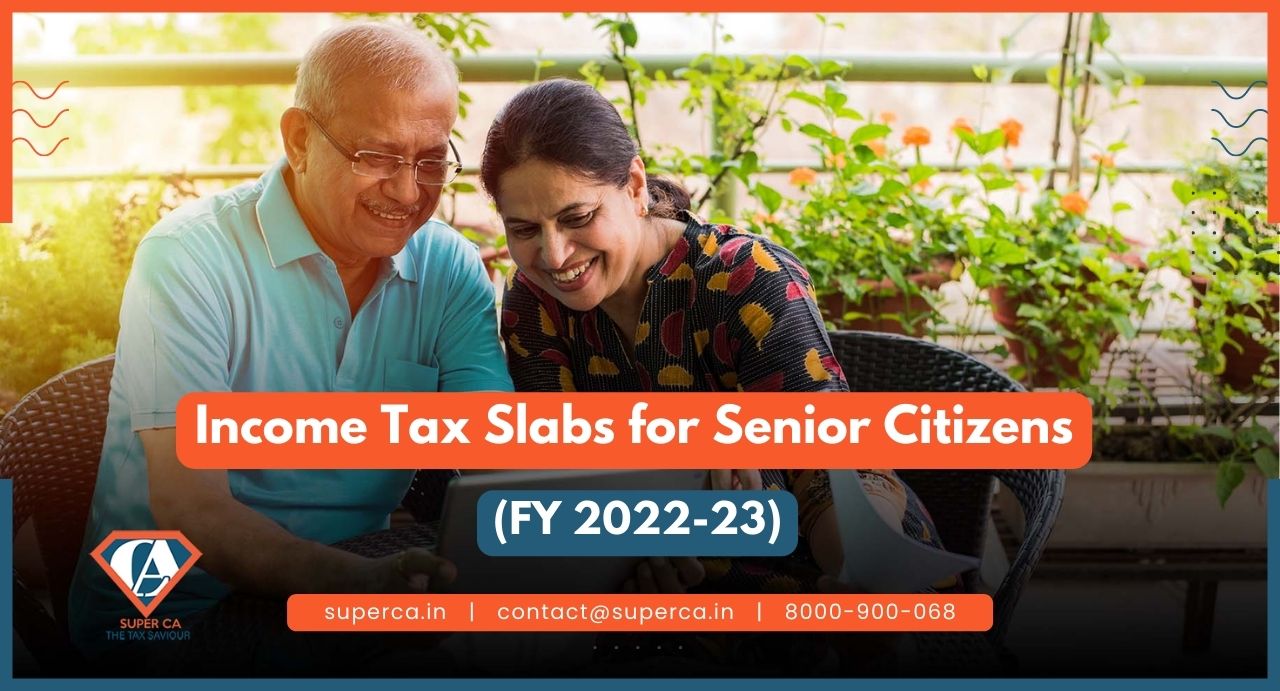Income Tax Slabs for Senior Citizens (FY 2022-23)


Every person/business who is earning income during the financial year has to file income tax as applicable to them. It is mandatory for individuals/businesses to file their tax returns timely who have income above the basic exemption limit under the Income Tax Act, 1961. However, they can file a voluntary nil tax return even if their income is below the threshold limit. The “income” could be in the form of a stipend, profits from business, income from house property or earned through dividends, capital gains, interests or other like sources.
Income Tax slab rates are different for different categories of taxpayers. Income tax has classified three categories of “individual “taxpayers as:
- Individuals (aged less than of 60 years) including residents and non-residents
- Resident Senior citizens (60 or older but under 80 years of age)
- Resident Super senior citizens (80 years of age or older at any point in the previous financial year is referred)
In this article, our discussion will revolve around the tax brackets and benefits that are available to senior and super senior citizens for FY 2022-23
Section 115 BAC of the Income Tax Act provides for a lower rate of taxation for Senior and Super Senior Citizens. They may choose the Old Tax Regime or the New Tax Regime for AY 2022-23. However, there are several exemptions and deductions, such as 80C, 80D, 80TTB, and HRA, that are not available to taxpayers who choose tax concessions rates under the New Tax Regime when compared to the old tax regime.
| Existing Tax Regime | New Tax Regime u/s 115BAC | ||
| Income Tax Slab | Income Tax Rate | Income Tax Slab | Income Tax Rate |
| Up to ₹ 3,00,000 | Nil | Up to ₹ 2,50,000 | Nil |
| ₹ 3,00,001 - ₹ 5,00,000 | 5% above ₹ 3,00,000 | ₹ 2,50,001 - ₹ 5,00,000 | 5% above ₹ 2,50,000 |
| ₹ 5,00,001 - ₹ 10,00,000 | ₹ 10,000 + 20% above ₹ 5,00,000 | ₹ 5,00,001 - ₹ 7,50,000 | ₹ 12,500 + 10% above ₹ 5,00,000 |
| Above ₹ 10,00,000 | ₹ 1,10,000 + 30% above ₹ 10,00,000 | ₹ 7,50,001 - ₹ 10,00,000 | ₹ 37,500 + 15% above ₹ 7,50,000 |
| ₹ 10,00,001 - ₹ 12,50,000 | ₹ 75,000 + 20% above ₹ 10,00,000 | ||
| ₹ 12,50,001 - ₹ 15,00,000 | ₹ 1,25,000 + 25% above ₹ 12,50,000 | ||
| Above ₹ 15,00,000 | ₹ 1,87,500 + 30% above ₹ 15,00,000 | ||
| Existing Tax Regime | New Tax Regime u/s 115BAC | ||
| Income Tax Slab | Income Tax Rate | Income Tax Slab | Income Tax Rate |
| Up to ₹ 5,00,000 | Nil | Up to ₹ 2,50,000 | Nil |
| ₹ 5,00,001 - ₹ 10,00,000 | 20% above ₹ 5,00,000 | ₹ 2,50,001 - ₹ 5,00,000 | 5% above ₹ 2,50,000 |
| Above ₹ 10,00,000 | ₹ 1,00,000 + 30% above ₹ 10,00,000 | ₹ 5,00,001 - ₹ 7,50,000 | ₹ 12,500 + 10% above ₹ 5,00,000 |
| ₹ 7,50,001 - ₹ 10,00,000 | ₹ 37,500 + 15% above ₹ 7,50,000 | ||
| ₹ 10,00,001 - ₹ 12,50,000 | ₹ 75,000 + 20% above ₹ 10,00,000 | ||
| ₹ 12,50,001 - ₹ 15,00,000 | ₹ 1,25,000 + 25% above ₹ 12,50,000 | ||
| Above ₹ 15,00,000 | ₹ 1,87,500 + 30% above ₹ 15,00,000 | ||
| Forms | Applicability |
| ITR 1 (Sahaj) | For resident Individual who have income upto Rs 50 Lakh from Salary/One house property or other sources (eg. Interests) |
| ITR 2 | For Individuals and HUFs having income business or profession, from capital gains, or having foriegn incomes or holding foriegn assets. |
| ITR 3 | For individuals and HUFs having income from business and profession And presumptive Income in excess of Rs 50 Lakh |
| ITR 4 (Sugam) | For Individuals who opted for presumptive income scheme u/s 44AD/44DA/44AE and have a total income from business/profession upto Rs 50 Lakhs |
| ITR 5 | For Limited Liability Partnerships (LLPs), Association of persons (AOPs), Body of Individuals (BOIs), Trust and people under IT Act. |
| ITR 6 | For companies other than those claiming exemption u/s 11 on charitable or religious purposes. |
| ITR 7 | For people and companies required to furnish return under Section 139 (4A), Section 139 (4B), Section 139 (4C), Section 139 (4D) |
Filing an income tax return is an explicit way of declaring one’s total income. Whether young or senior citizens, filing Income-tax not only helps you but also helps the nation. The tax that people pay is used by the government to build infrastructure and to improve other facilities of the nation such as medical, defense, etc. Hence, all compliances should be met before the due date to avoid any unnecessary penalties and consequences. Moreover, Income Tax Return holds immense legal value and is recorded with the government.
Suggested Read:
What Is The Difference Between Income Tax And TDS?
What Is Form 16 And How To File Your Income Tax Return Online?
Income Tax Deductions Under Section 80C, 80CCC, 80CCD & 80D

|
Essential LLP Registration Documents: A Complete Checklist for Entrepreneurs Author: Rahul Singh 04 Apr, 2024
|
Get inspired by these stories.